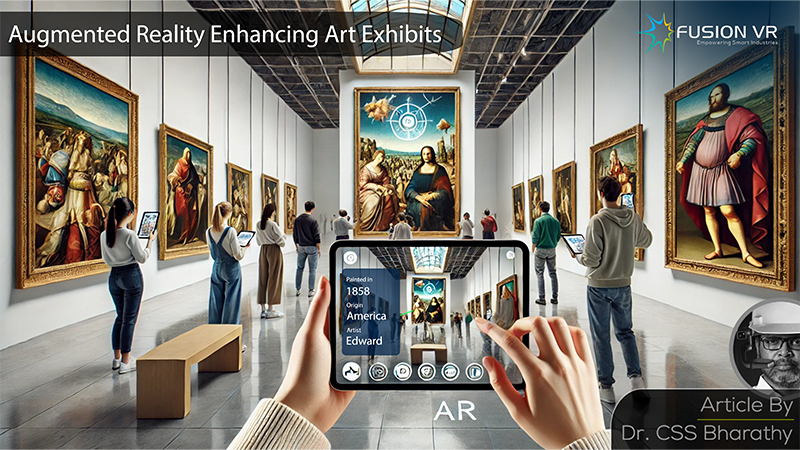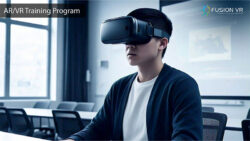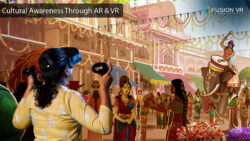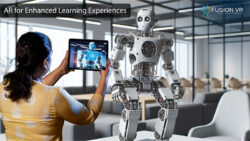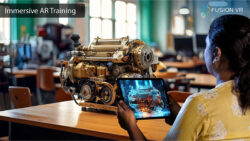Museums are becoming popular places for people to visit and enjoy quality time with friends and family. The static displays of traditional museums will soon become a thing of the past and they are currently being transformed into digital museums with highly interactive and immersive experiences and exhibits. The influence of high technology in today’s museums is immense and one of the main technological influences comes from Augmented reality or AR.
AR as a technology is not new. We have been using it even without realizing it. The mobile phone and its vast array of communication technologies has spawned a multitude of applications that are both useful as well as entertaining. Many people have played Pokemon Go and may not have realized that AR has powered it or the directional signs that Google maps provide when viewing a real street environment. Augmented reality is simply the overlay of digital content onto many of the devices we use today such as smartphones, tablets as well as highly sophisticated AR wearable devices. The content delivered is relevant, contextual, location specific and immensely beneficial.
Art and culture is extremely important to us as human beings. We would like to preserve and promote traditional art forms while at the same time encouraging the growth and development of newer ones. Museums provide a great way to showcase what we have and highlight the more novel ones that are being created. They are revolutionizing the way museums are promoting arts and culture by making the visitor experience that is much more interactive, immersive and loaded with educational content as well as entertainment value. Museum 2.0 companies like Fusion VR are helping museums find new ways to create, operate and maintain augmented reality exhibits and experiences at museums.
With everyone wielding a smartphone these days, the most convenient way to introduce AR is through these ubiquitous devices. Augmented reality applications or apps effectively deliver content and guidance in the hands of the museum visitor. Every museum contains a vast trove of cultural and artistic treasures that most people walk by and are unaware of their value and significance. Museums have developed applications that allow visitors to scan a painting or artifact using their smartphone. The app then launches a menu of options to explore the artifact. The information could be textual, audio and video, depending on the visitor’s preferences. The application could also provide a 3D model of the artifact which can be rotated in any direction, allowing the visitor to get a complete view of the object. The audio visual content could also contain videos of experts who provide interesting insight about the artifact. The Smithsonian Museum is a leader in this arena and has developed an app that overlays its prehistoric animal skeleton exhibits with virtual skin and helps visitors see how these animals looked when they inhabited the earth.
Museums are also enabling their visitors to obtain a more immersive experience by providing them with AR smart glasses such as HoloLens and something that is hands free. The user wears HoloLens as in the Cleveland Museum of Art and explores digital reconstruction of the artworks found in the museum and also gets to understand the creativity and work processes of the artist. This augmented reality in museums experience is great for both casual art enthusiasts and the academic and professional visitors who wish to apply those techniques to their creations. The National Museum of Finland also uses the HoloLens to enable visitors to visualize the impact of climate on the ecosystem using immersive 3D holograms. This exhibit called the 6th Extinction highlights how AR can be deployed to create a powerful impact not only on art and culture but also using art to highlight some of the critical issues facing the human race.
The National Museum in Singapore and the National Gallery in the United Kingdom are using AR projections to enhance the viewing experience and to recreate original settings for artwork in their heyday. Typically, AR projections deploy sophisticated projectors that help to overlay digital content created over surrounding physical structure, objects and spaces. These projections dramatically transform museum spaces, halls, and rooms into engaging immersive environments. The augmented reality projections create context and meaning for the artwork compared to just having them displayed. Projections also enable the addition of dynamic information onto the static displays. This type of experience and engagement that museums create for art and culture is remembered by visitors for a long time and is most likely to be shared with family and friends.
Another very interesting way in which museums are putting AR for arts and culture is with AR guides. It has become quite difficult to find quality museum tour guides. Moreover, the expertise required takes a considerable amount of time as well. Finally, they are expensive and may not be available when we need them. Augmented reality devices and wearables have been deployed in museums such as the National Gallery of Australia and The American Museum of Natural History to guide visitors. These AR guide apps help visitors with information about an artifact, painting, exhibit or experience through their devices. The guidance for visitors would be in text, audio voice over, visual or all three combined. An expert voice providing all the information needed is much like having a physical guide with the visitor. The app tends to provide more information and is also interactive. The app would provide an interactive 3D model of the artifact to help the visitor appreciate the artifacts in greater detail.
These AR guides are even more exciting in the hands of young visitors. They tend to absorb all the information provided or shared like a sponge. AR based educational applications are often designed to capture the attention and imagination of young children. The learning experience can be customized and integrated with their school curriculum. The museum visit and AR experiences will supplement their academic efforts at school. These apps would include games, quizzes, puzzles that are interactive and engaging. The winners would also receive badges and other kinds of recognition that could be helpful in their academic endeavors. The Natural History Museum in the UK has the NHM Alive application that was developed in collaboration with David Attenborough. This app delivers an interactive learning experience on animals from the prehistoric era. This kind of learning experience maximizes the engagement and retention of young children.
The coolest thing about AR is that it’s quite adaptable in terms of device. The profusion of smartphones has made the wide use of augmented reality more easier. Museums adopting augmented reality, virtual reality technologies and implementing them in the transformation of traditional museums into the modern interactive museums is under the umbrella of Museum 2.0. While museums are not typically staffed with augmented reality technologists, the technical staff will certainly benefit from an awareness of how this technology can help further their efforts. This is where experienced and knowledgeable subject matter experts such as Fusion VR step in. Our experience in the museum area spreads over two decades, often helping clients discover new technologies, applications and visitor experiences. We have the ability to recommend the best suite of technologies, hardware, software for the most engaging interactive visitor experiences for augmented reality experience centers. We highly recommend it as it saves time, effort, money and a lot of rework, if one engages inexperienced service providers as the use of AR in museums is growing exponentially. Our staff are available on short notice to discuss proposals and solutions that are not only of high quality, but also cost effective. We recommend that you visit our Museum 2.0 webpage to learn more about our approach, our highly successful projects and more about augmented reality museums experience in general.
In conclusion, museums are investing considerable time and effort in deploying AR in museums for the growth and development of the arts and culture ecosystem in the country. This is driving greater interest, engagement, and delivering memorable experiences for its visitors.

